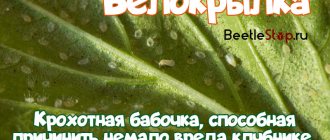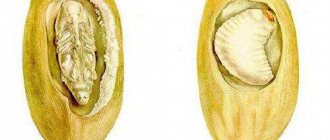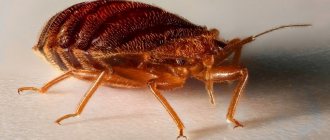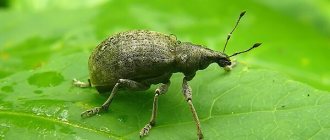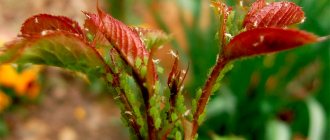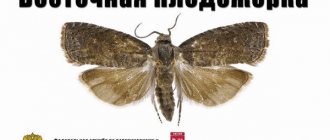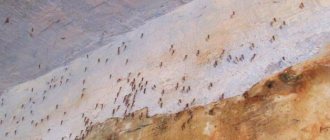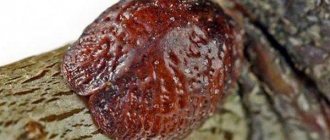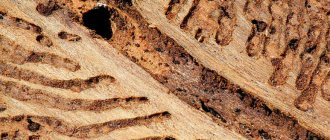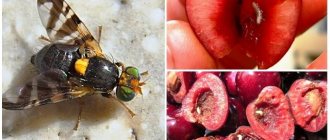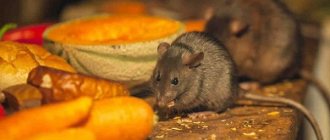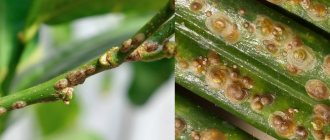Are you familiar with this picture: instead of blooming, the buds on the apple tree become brown and dry? And inside each such bud a yellowish larva happily lives. Who chewed out the buds from the inside? Who ate all the apple blossom?
The apple weevil (also known as the apple tree beetle) is a malicious pest of apple trees that lives everywhere. If the cool spring is favorable for the bug and there are a small number of buds, it can completely deprive us of the harvest.
You need to fight the flower beetle, you can get rid of it, but preventing it from appearing in the garden is not so difficult. Therefore, we invite you today to arm yourself with information, as they say, to get to know the enemy “by sight.” And, of course, understand all possible means of combating it.
general characteristics
The apple flower beetle (Anthonomus pomorum) belongs to the weevil family, order of beetles. Since the insect feeds on the formed buds of a pear or apple tree, it can cause serious damage to the crop.
Appearance
Adult individuals are characterized by a small size: from 0.3 to 0.5 cm. The legs, abdomen and back of the beetle are dark brown, and the elytra (elytra) are light brown in color with dark stripes.
The oval body is covered with thin light gray hairs, almost invisible at first glance. The insect's head, extended forward, has a triangular shape. Its front part is a thin, elongated proboscis, short in males and long in females. At the end of the proboscis there is a mouth. The apple flower beetle is characterized by the presence of three pairs of teeth. The wings provide maximum mobility for this insect.
Life cycle
In three phases of development, the beetle looks like this:
- The egg is oval in shape and white, almost transparent, in color. Dimensions vary from 0.5 to 0.9 mm. Each insect clutch contains from 50 to 100 eggs.
- The larva has a curved shape, its front part is thicker. The body is colored light yellow, and the head area is dark brown. The larva has no legs.
- Pupa - has the same size and shape as that of the imago. On the yellow body you can see signs of the formation of wings, proboscis and legs. There are 2 spines on the abdomen.
During the season, the apple flower beetle forms no more than one generation.
Distribution area
Anthonomus pomorum is a fairly common insect; it can be found almost everywhere where domestic apple trees grow. The boundaries of the range of this pest in Eurasia are as follows:
- in the east - China, Korea, Japan; Primorye, Manchuria, Japanese Islands, Far East;
- in the west - all of Europe;
- in the south - the Caucasus;
- in the north – the 59th parallel (including St. Petersburg).
The beetle is especially common in the southern regions, where gardens adjoin forests with wild pears and apple trees.
Lifestyle
The apple flower beetle is a fully metamorphosed insect with a development cycle of 35 to 40 days. In winter, these insects are at the adult stage; in cold weather, they crawl deep into the bark of apple trees or into the leaf litter located near the trees. At the beginning of spring, after the temperature rises to +6 °C, the beetles wake up and move to the upper part of the bark.
Food for weevils is the buds of flowers and leaves swelling on the tree.
Basically, pests prefer to settle on various varieties of apple trees, but they can also be found on pears. The largest concentration of beetles is observed on trees located at the edge of the garden. During the flowering period of the apple tree, after its buds open, insects begin to mate. The fertilized female makes a hole in the petals and lays eggs between the stamens. This usually happens at the end of April.
The formed larva eats the pistil and stamens in the flower, and its excrement remaining inside the bud glues the petals together. Damaged flowers first turn brown, and then dry out and fall off. Young individuals remain in bud until their chitinous coverings harden. After which they gnaw their way out and feed on the leaves. The wings allow the weevils to attack nearby trees.
The mass flight of these insects occurs simultaneously with the excess ovary flying from apple trees - in late May and early June.
Damage caused
Weevils are characterized by good fertility: beetles quickly multiply and settle in new territories, damaging trees, which negatively affects their health.
The buds eaten by the larvae do not form fruits. Unopened buds are a sign of pest damage to the apple tree. Damaged areas are clearly visible on a green tree due to their brown color and inconspicuous appearance. In sunny weather, you can see the juice secreted by the affected buds, as well as small holes with eggs laid by the beetle.
In faded apple trees, weevils eat the foliage, gnawing openwork holes in it.
Ignoring the problem will result in crop loss as rapidly reproducing insects will overrun the entire garden.
Harm to the garden
The larva eats up the pistil and stamen in the bud, and therefore the ovary and fruit are not formed.
The flower beetle is most dangerous in the long spring. The risk of crop loss appears if more than 50% of the buds are damaged in case of heavy flowering, and up to 30% in case of weak and moderate flowering. If you take care of the garden, process it in a timely manner, and clean it from pests, then the crop can be protected from the pest.
To reduce the likelihood of your garden becoming infected with the apple blossom beetle, you need to choose the right area for your garden. It should be kept as far away from wild fruit plants as possible. Most of the beetles are around the perimeter of the garden, next to the forest belt.
If the pest has already laid eggs, the buds do not open; transparent drops are visible on them. They need to be torn off and destroyed, preventing beetles from developing.
Varieties resistant to flower beetle
For those gardeners who do not have enough time to treat fruit trees to combat the apple blossom beetle, experts recommend breeding varieties that are not susceptible to pest invasion. These include:
- fontanel;
- Vasilisa;
- Mascot;
- Red poppy;
- Linda;
- Prima;
- Red amber;
- Aphrodite;
- Fairy;
- Union.
These apple trees are not subject to serious diseases inherent in other varieties.
Methods for controlling weevils
The optimal time to get rid of pests is spring. It is recommended to carry out all activities before the buds begin to bloom, which will prevent the appearance of a flower beetle. There are several ways to kill a beetle:
- chemical;
- biological;
- mechanical;
- use of traps.
Effective chemicals
Pesticides are considered the most effective means of getting rid of weevils. The most common of them include:
- "Calypso";
- "Decis";
- "Inta-Ts-M";
- "Karbofos";
- "Aktara";
- "Kinmiks";
- "Tanrek";
- "Engio."
If this or that drug is used for the first time, then before treating the entire garden it is necessary to test it on one of the apple trees and observe the condition of the tree during the day.
Processing technique
Most chemicals used to combat flower beetles must be diluted with water in the proportions specified by the manufacturer. Spraying is carried out using a spray bottle, and it is recommended to adhere to a number of rules:
- dilute the concentrate in accordance with the measuring instructions;
- carry out the treatment in warm and dry weather, otherwise rain and wind will prevent the composition from penetrating into the affected areas of the apple tree;
- use personal protective equipment (gloves, mask) due to the toxicity of some drugs;
- work should be carried out at the flowering stage, which will prevent the insecticide from entering the resulting fruit.
For the procedure, it is best to use a spray bottle equipped with a long hose, which allows you to treat the upper part of the apple tree.
It is recommended to spray the drug at a distance of 70–90 cm. All parts of the tree are subject to treatment: trunk, branches, foliage, as well as the area of land around (within a radius of 1 m). You can achieve maximum results only with the right approach to getting rid of beetles. Experienced gardeners recommend integrated pest control, including chemical, agrotechnical methods and prevention.
Processing time
You can get the expected result from spraying trees only if it is carried out in a timely manner. In the spring, similar events are performed four times:
- along bare apple trees;
- during the formation of kidneys;
- when buds appear;
- after flowering, according to the ovaries that appear.
Before the flowering period
The first spraying should be carried out before the formation of inflorescences on the apple trees, that is, in early spring. This is due to the inability of chemicals to cope with the eggs and larvae of the weevil. Pesticides kill only adult individuals. As already mentioned, in the spring the procedure is performed three times: completely bare trees are treated, then with swelling buds and then on buds that have protruded but have not yet opened.
After flowering
A new generation of weevils gnaws holes in the dried buds and appears after the end of the flowering period. At this time, the apple tree sheds excess ovaries. Within 14–20 days, young insects move to leaves and ovaries, eating them and causing damage. At this time, the trees are re-sprayed with pesticides. Experts recommend alternating reagents to prevent pests from becoming accustomed to one composition.
During the period of fruit ripening
In mid-summer, the activity of flower beetles decreases: the beetles go into a dormant state and do not need food. At this time, fruit formation occurs, so spraying the apple tree with chemical compounds is unacceptable.
Autumn procedure
Immediately after harvesting, the trees are treated again to significantly reduce the number of pests before they leave for the winter.
In the fall, it is recommended to collect and burn fallen leaves, and then dig up the soil near the apple trees. To avoid mass reproduction in the next season, it is necessary to tear off and burn brown unopened buds. The use of pesticides during the period of pollination of apple flowers by bees is prohibited.
Spray frequency
The timing of tree processing is determined by the climatic conditions of a particular region, varieties and age of apple trees. In the spring, spraying is carried out in accordance with the basic rules, in the summer - as needed, and in the fall - before the leaves fall.
Preventive measures
Simple preventive measures can prevent the harmful actions of the apple blossom beetle:
- The peeling bark serves as a winter refuge for weevils. It is removed, and the exposed areas are covered with a lime mixture.
- Fallen leaves, weeds and branches are raked into piles and burned. Some of the beetles will die in the fire, individuals buried in the soil will remain in the cold without shelter and freeze.
- The tree trunk area is dug up, removing weevils from the soil.
Preventative work is carried out in the fall.
Processing in different regions
The first spraying of apple trees in different areas does not occur at the same time due to the characteristics of their climate. The following factors will indicate the need for the procedure:
- lack of snow;
- not yet swollen buds;
- air temperature from +4 to 5 °C.
The second treatment is performed when the temperature reaches +15 °C. As a rule, this occurs 2 weeks after the first spraying. At this time, a green cone appears (bud swelling occurs). In the future, measures related to the elimination of the flower beetle are carried out upon the formation of buds and after harvesting.
Chemical-free methods
In addition to using pesticides, there are several other ways to combat weevils. All of them are easy to implement and, if done correctly, are quite effective.
Biological measures
This method of getting rid of apple blossom beetle is safe.
Since insects prefer dense plantings, it is recommended to plant apple trees in an open, well-lit place, away from abandoned orchards and wild apple trees. Some birds enjoy feasting on weevils , for example:
- redstarts;
- nuthatches;
- tits;
- flycatchers.
To attract birds, you need to hang feeders in your garden, this will reduce the pest population.
Beetles can also be controlled using traps . For this purpose, in early spring, the apple tree at the base of the trunk is wrapped with a belt impregnated with insecticides. Due to the inability to overcome the created barrier, the weevil remains without food and dies.
Mechanical method
Despite the labor intensity and lack of effectiveness, this method of combating the apple blossom beetle is popular among gardeners. Its peculiarity lies in collecting pests by hand or shaking them off the tree . In the first case, the beetles are immediately placed in salt water, and in the second, they fall onto an oilcloth or cloth previously spread under a tree, after which they are swept away and burned.
The mechanical method is relevant in early spring after the air has warmed up to a temperature of +5–6 °C, since at this time insects crawl out of their wintering places. The best time for such an event is considered to be morning. To achieve maximum results, it is necessary to carry out at least three such procedures from the moment the beetles emerge from hibernation and before flowering begins.
Folk remedies
Often, gardeners use folk remedies to destroy pests - less effective, but safe for human health and the environment. For this purpose special formulations using the following recipes:
- Medicinal chamomile inflorescences are poured with hot water in a ratio of 200 g per 10 liters and left for 24 hours. To ensure a good bond, laundry soap is added to the resulting solution.
- Fir cones are placed in 1 liter of water and left in a warm place for 2 weeks. After this time, the fermented composition is filtered and diluted in a bucket of water.
- Dried wormwood in the amount of 400 g is poured with water and left for 24 hours. Then filter and bring to a boil over low heat. Laundry soap is added to the hot tincture.
Treatment with prepared products is performed once a week. Procedures are permissible at the beginning of the growing season, during flowering and fruiting.
Description of the species
The apple blossom beetle (Anthonomus pomorum) is a small beetle from the weevil family. The adult body size is 3-5 mm. The body shape is oval, the head is elongated. The color is brownish-brown. The entire body and limbs are covered with gray hairs. The anterior part of the head passes into the rostrum or proboscis. This is the hallmark of weevils. The organ ends with a gnawing type mouthparts. Club-shaped, crank-shaped antennae. Legs with a reddish tint, large teeth on the hips.
Information. Sexual dimorphism of insects is manifested in the structure of the rostrum. In males it is shorter than in females and slightly curved.
The larva is light yellow in color and has a sickle shape. Body length 5-6 mm. The head is brown, the legs are reduced, and there are many tubercles on the back. The pupa retains the size of the larva, but has the rudiments of wings, rostrum and limbs.
